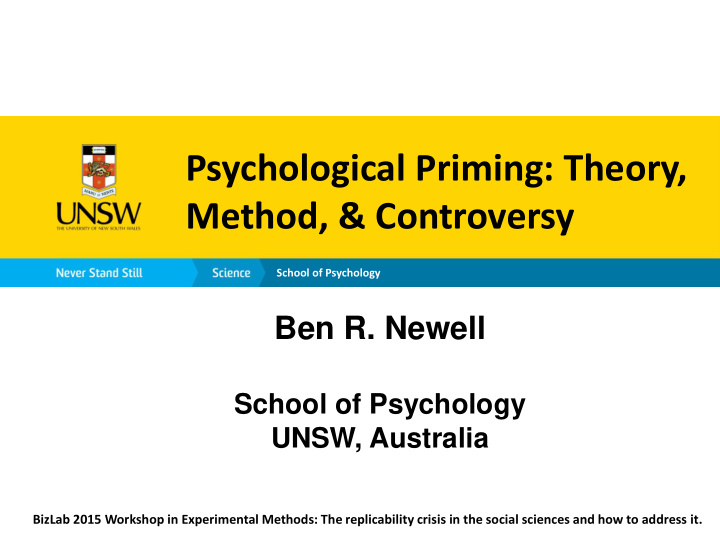



Psychological Priming: Theory, Method, & Controversy School of Psychology Ben R. Newell School of Psychology UNSW, Australia BizLab 2015 Workshop in Experimental Methods: The replicability crisis in the social sciences and how to address it.
bread bread bread butter Word or not?
• Thinking of old people makes you walk slower • Thinking of intelligent people makes you more intelligent • Thinking of romantic partners makes you pay more for conspicuous consumer goods • Holding warm cups increases perceived warmth of a stranger • Connecting dots on a piece of paper makes you feel emotionally closer to family
(Ir)rationality assumption • BREAD ----- BREAD NURSE---DOCTOR • Connecting dots
How does (social) priming work? • Stimulation of mental representations of a target, event, situation • Downstream (long lasting) consequences on behaviour • Outside awareness OR • Outside intention to utilize activated representation “subtly influences peoples responses even when they do not deliberately connect these cues to their current thoughts and actions” (Molden, 2014)
Direct access or misattribution? • Raised accessibility directly impacts behaviour (automatic activation – Bargh) • Accessibility plus misattribution – Failures of ‘source monitoring’ introduces errors and produces priming.
“If , for example, people were exposed to words related to the concept of hostility (e.g., “hit,” “punch,” “aggress”), it could reasonably be predicted that they would subsequently: • (a) be faster to identify a gun (semantic priming) • (b) perceive another individual as more hostile (construal priming) • (c) behave in a more hostile manner themselves (behavior priming) • (d) become motivated to actively seek out an opportunity to aggress against some other person or object (goal priming)” Loersch & Payne, 2011
P Cognitive R I M SOCIAL E
Method • “It doesn’t seem like rocket science” • Priming material (word lists, anagrams, drawing task) • Target behaviour (walking, risky choice, intelligence) • Measure(s) of target behaviour
Priming intelligent behavior? Phase 1: list the appearance, lifestyle, and behaviour of a typical professor/soccer hooligan Phase 2: answer multiple-choice general knowledge questions What is Europe’s longest river? Danube/Volga/Dnieper
“9 experiments with 475 participants… none of the experiments obtained the effect. …A Bayesian analysis reveals considerable evidential support for the null hypothesis”.
“the Shanks et al. paper will only lead to skepticism about (non)replications. Moreover, publishing sub-standard experiments is harmful to colleagues, it is misleading to readers, and it is damaging to science .” “We do not believe it is appropriate in a scholarly exchange to suggest, without concrete evidence, that another group’s research practices are unprofessional .” http://www.plosone.org/article/info%3Adoi%2F10.1371%2Fjournal.pone.0056515
Priming Risky Choice Prime: risk-seeking ( adventurous ), risk-averse ( careful) words rank frequency Target Behaviour: risky choices in vignettes (e.g., bet on long-shot vs favourite) Measure: proportion of risky choices Newell & Shaw (under review)
Priming Risky Choice Experiment 1: Replicate predicted pattern (in NHST, partially in Bayesian stats) Experiment 2: null result Experiment 3: null result Newell & Shaw (under review)
Reliability vs. validity, or generalisability – what do we want to know?
PRIME TARGET
Mean effect size More precise smaller effect Less precise larger effect
“The studies are like a torrent, rolling down the mountain of significance. The image is not so much a funnel plot as an avalanche plot .” ( Neuroskeptic blog) “evidence of either p-hacking in previously published studies or selective publication of results (or both ).” (Shanks et al., 2015)
Förster, J., & Denzler, M. (2012). Sense creative! The impact of global and local vision, hearing, touching, tasting and smelling on creative and analytic thought. Social Psychological and Personality Science, 3 , 108-117.
PRIME TARGET “How typical is the word ‘wheelchair’ for the category of ‘vehicle’?”
Typicality
Field, Wagenmakers, Newell, Zeelenberg, & van Ravenzwaij (in revision, registered @ JEP: GEN)
Resolution? • Improve research practices - transparency • Improve theory? • “Us” vs. “them” (is bad)
“the most exciting time to be an Australian ”
Thank you for listening Additional References: Newell, B.R., & Shanks., D.R. (2014). Prime Numbers: Anchoring and its Implications for Theories of Behavior Priming. Social Cognition, 32, 88-108. (Republished in): Molden, D. (Ed). (2014). Understanding priming effects in social psychology . New York, NY: The Guilford Press. ben.newell@unsw.edu.au
Recommend
More recommend